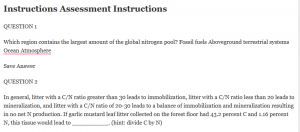Instructions Assessment

QUESTION 1
Which region contains the largest amount of the global nitrogen pool? Fossil fuels Aboveground terrestrial systems Ocean Atmosphere
Save Answer
QUESTION 2
In general, litter with a C/N ratio greater than 30 leads to immobilization, litter with a C/N ratio less than 20 leads to mineralization, and litter with a C/N ratio of 20-30 leads to a balance of immobilization and mineralization resulting in no net N production. If garlic mustard leaf litter collected on the forest floor had 43.2 percent C and 1.16 percent N, this tissue would lead to __________. (hint: divide C by N)
immobilization
mineralization
a balance of immobilization and mineralization
preferential consumption
Save Answer
QUESTION 3
Carbon dioxide concentrations fluctuate in predictable seasonal patterns on the surface of the planet largely as a result of _____________.
the influence of vegetation patterns in tropical systems weathering of rock surfaces following seasonal rain events vegetation growth and flux patterns in aquatic systems large-scale patterns of terrestrial plant uptake and dormancy
Save Answer
Question Completion Status:
Click Save and Submit to save and submit. Click Save All Answers to save all answers.
1/4/2021 Take Test: Unit VI Assessment – BIO 1302-17C-FA21L-S2, …
https://online.columbiasouthern.edu/webapps/assessment/take/launch.jsp?course_assessment_id=_498516_1&course_id=_111010_1&content_id=_6… 2/5
QUESTION 4
Which of the following is the slowest to decompose? Proteins Sugars Lignins Cellulose
Save Answer
QUESTION 5
Which of the following nutrients is most closely linked to the energy cycle in ecosystems?
Carbon Nitrogen Lead Sulfur
4 points Save Answer
QUESTION 6
Match the answer to the question.
________ is the process by which plants absorb a portion of their nutrients from senescing tissues to be stored and used for the production of new tissues.
The breakdown of chemical bonds that were formed during the construction of plant and animal tissues is called ________.
The release of organically bound nutrients into an inorganic form is called ________.
The introduction of high levels of nutrients into a body of water is called ________.
Precipitation brings appreciable quantities of nutrients into ecosystems that are collectively called ________.
Large quantities of nutrients are bound tightly in ________ structure; they are not readily available until released by the activities of decomposers.
Some nutrients are ________ from the soil and carried out of ecosystems by underground water
ecosystems by underground water flow to streams.
The element ________ is a basic constituent of all organic compounds and is involved in the fixation of energy by photosynthesis.
The difference between the rate of carbon uptake in photosynthesis and the rate of carbon loss due to autotrophic and heterotrophic respiration is the net ________ productivity.
Nitrogen is generally available to plants in only two forms: ammonium and ________.
Biological nitrogen fixation is accomplished by symbiotic ________ living in mutualistic association with plants.
Nitrogen can be returned to the atmosphere when certain bacteria convert it from nitrate into nitrogen gas, which is a process called ________.
Microbial decomposition of organic matter results in NH4+ production through a process called ________.
Nearly all of the phosphorus in terrestrial ecosystems comes from the ________ of calcium phosphate minerals.
___________ develop as a result of incomplete decomposition of organic matter in swamps and marshes.
The process of ____________ produces a form of nitrogen that is easily lost from soil through leaching.
____________ is when too much nitrogen enters an ecosystem and causes forest decline.
_________ primary productivity is the total rate of photosynthesis or energy assimilated by plants.
Plants assimilate energy through the process of _______________.
___________is the process that releases carbon dioxide in the atmosphere.
ecosystem
retranslocation
nitrogen saturation
bacteria
Question Completion Status:
Click Save and Submit to save and submit. Click Save All Answers to save all answers.
QUESTION 7
First describe three ways that nutrients can be lost from an ecosystem; then describe how nutrients are replaced in those systems.
Your response should be at least 75 words in length.
P 0 WORDS POWERED BY TINY
Save Answer
For the toolbar, press ALT+F10 (PC) or ALT+FN+F10 (Mac).
QUESTION 8
Describe the effects of temperature, moisture, length of photosynthetic period, and nutrient availability on net primary productivity in terrestrial ecosystems. Give examples in your explanations.
Your response should be at least 200 words in length.
P 0 WORDS POWERED BY TINY
30 points Save Answer
Question Completion Status:
Paragraph Arial 14px
Paragraph Arial 14px
Click Save and Submit to save and submit. Click Save All Answers to save all answers.